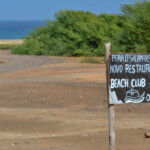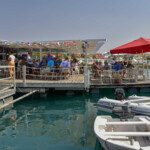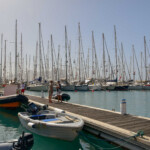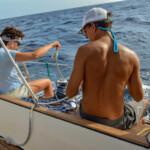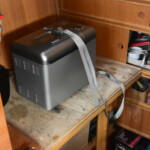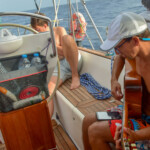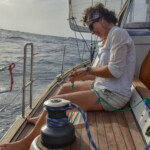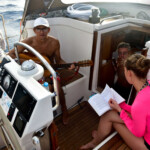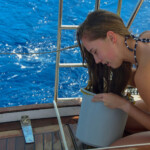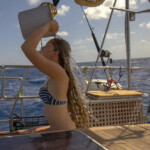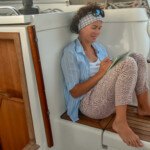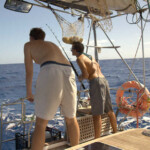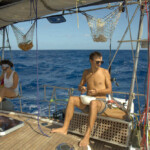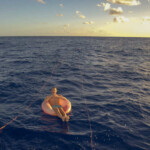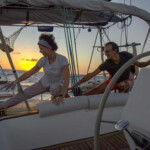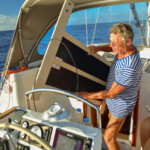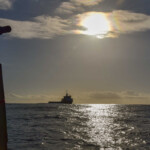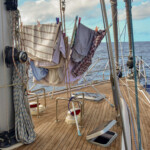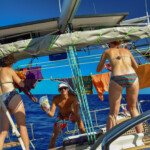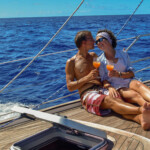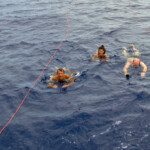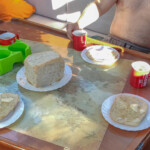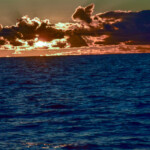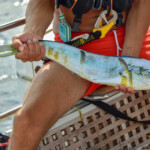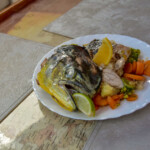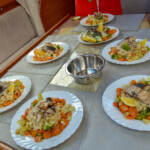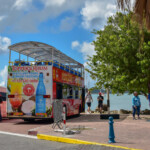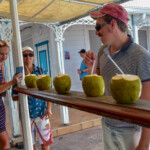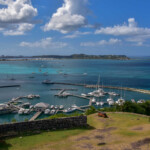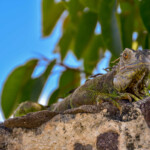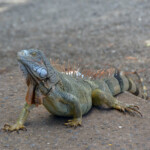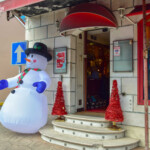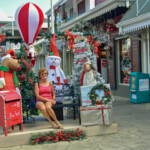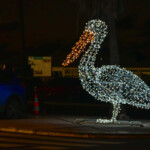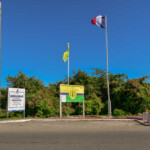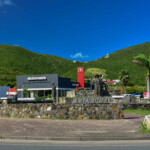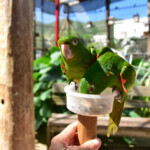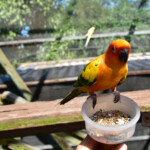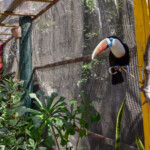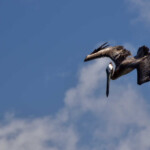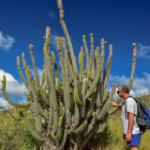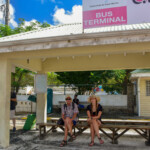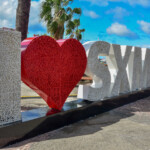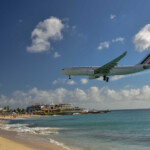Route: Mindelo(Sao Vincente) – Marrigot (Saint Martin)
Date: 13.11-6.12.2023
Miles/ hours: 2181 Mm/526h
November 12, we go on a trip to Baia das Gatas, swim in the ocean and return to Mindelo. In the evening, Dorota and Mateusz sailed to land, but it turns out that the marina is a closed event, so you can’t take the boat to the pier. Fortunately, there is also a quay at another bar and we pick them up there.
November 13, in the morning, part of the crew goes ashore for some last-minute shopping, then dinner and we set sail at 4 p.m. We say goodbye to Mindelo, we have 2,400 miles of sailing ahead of us. In the evening we sail into the shadow of the island of Santo Antao, so first we put on the mainsail, and if that doesn’t help, we turn on the engine. After leaving the shadow of the island, the wave becomes sharp and comes from different directions. One of them tilts the yacht and we take the water through the side windows. Fortunately, there are no major losses, although in the morning it turns out that the nut and the arm of the winch have drowned.
November 14, in the morning we caught a fish, not very big, but we’ll try it. In a moment, another similar fish is caught on the second rod – two is already something. We also find a small squid and a small flying fish on board.
We turn on the watermaker and fill the large water tank and two 8-liter canisters. Encouraged by these achievements, Mateusz starts checking the baits more often. Unfortunately, two seagulls are caught one by one, but fortunately they detach themselves without destroying the bait. In the evening we change the genoa to the jib and this time the night is calm.
November 15, in the morning, dolphins visit us – they are spotted on top and have pink bellies. They flow with us for a while, but quickly flow away. For breakfast, cereal with fruit flakes and yogurt. Delicious. Tomek is struggling with air in the watermaker, and finally he decided to go slower and then it would be OK. So we change the genoa to the jib and sail at a speed of 4.5 kn until the evening. But we have a full 2.5 tanks of water. In the evening, our bread machine is fitted with a professional handle – we will bake bread every day :-).
November 19 The wind is weakening a bit, so we try to set up the gennaker. The first time the sheets get tangled, we throw it down and put it back up again. It blows up to over 15kn, which is a bit too much for this gennaker, but we are sailing at 8kn. Unfortunately, the gennaker cannot withstand this and breaks near the halyard, tearing the entire rear leech. This is how we lost the gennaker :-(, maybe we will be able to sew it somewhere when we reach land.
November 21, the wind decreases to 8kn. From the morning we fill the tank with fresh water from the watemaker. At the yacht’s speed of 3.5 kn, water is produced quickly (the desalination machine does not create air). We cross 40ºW and assume that this is the middle of the Atlantic, so we take a bath. We throw the wheel overboard with a rope tied to the left side at the stern, and the other rope is also tied to the wheel and on the other side at the stern. This creates an elongated pool in which we bathe in several rounds (someone always has to be on the yacht). The water is over 29ºC – it’s great. Everyone is very happy after the bath. While swimming, we drift about 1nm north. In the evening, Tomek reads aloud the next chapter of “The Crazy Boat”. After dark, a motor yacht passes us at a distance of 2 miles – it is sailing, like us, to St. Marteen.
November 22, at night, the wind increases a little and turns to the south, so we reef the genoa and sail a little harder. At this course and speed of laundry is impossible :-(.
November 23, at night, we sail between storms, a beautiful phenomenon, but fortunately far away. The wind increases to about 28 kn and changes direction to the west (how does it know where we want to sail?). We furl the sails and turn on the engine – we sail against the wind and waves, but we want to escape the thunderstorm. In the morning it starts to rain, quite heavily – we will have a salt deck washed away – always something :-).
In the evening the wind decreases so we turn on the engine again. We sail on the engine all the night
November 24, in the morning, Tomek bakes bread and turns on the watermaker. After breakfast, we turn on the laundry. A large cargo ship passes us at a distance of about 500 m, we wave hello and the ship moves on. In a few hours two motor yachts will pass us, but a little further – about 5 nautical miles – we can see them on the horizon.
We sail on the engine almost all day, and in the evening there is a bit of wind, so we set up the genoa and the mainsail. Since we have passed 45º west latitude, we turn our clocks back an hour – we now have UTC-3 time. For afternoon tea we eat cocoa with milk and semolina. It is very tasty.
November 25 Surprise in the morning – Dorota and Mateusz got engaged 🙂 at sunrise in the middle of the Atlantic. The wind is about 10 kn, but we sail hard, not in a hurry, but forward. Before lunch we stop for a swiming. The water temperature is 29ºC. Is great. Seaweed begins to appear in the water and catches itself instead of fish. Extra work…
November 26, in the morning, Tomek starts cleaning the foil and on the windows. He manages to clean one window. We sail all day long, maybe the speed is not deadly – 3.5kn, but at least we are in the right direction.
November 28, in the morning, the fuel tank runs out. We switch to the next one. It turns out that we filled up with lousy fuel, so we drain it and clean the filters for over an hour. From the night watch, there is bread without 6 sides – as we know, rectangular bread has 6 sides :-).
After breakfast, we take a bath and then start the engine. I am booking the marina in Port Luis. In the evening, after dark, we catch a fish – it has large teeth and is blue, about a meter long – from the description it is a snake mackerel. To remove it with the landing net, we have to stop the yacht completely, so we fold up the genoa.
November 29, in the evening, we caught a fish again – the same species, but bigger. After grooming the fish, we pour the wax and display what has been spilled on the front sail. We have a mountain, a child, a witch, a lion, a crocodile and a few other figures.
November 30, toast with eggs and cheese for breakfast. In the morning we practice approaching people. As humans, we use egg cartons with orange peels. We fish it out with a boathook. It survives 5 attempts and after the fifth attempt, after being fished out, it ends up overboard. In the evening we admire another beautiful sunset. In the evening, after dark, we catch the same fish again, but we release it.
December 2 Before noon we catch a large dolphin – it will be for dinner. After being taken out of the water, it changes color from light green, through white to navy blue. After grooming the fish, we test the MOB AIS in the life jackets – all of them work properly.
December 4 At night it dissipates to 25kn, but in the morning it decreases to 20kn. In the morning, Mateusz catches a large coryfen, 106 cm long. We sail at 5kn on the jib, so we have a problem with landing the fish, but after reducing the jib to almost zero and switching the engine to reverse, we achieve a speed of 2kn, so after a few attempts we manage to hook the fish. We pull it out with a hook and groom it on board. We throw the insides overboard and the fish is cut into smaller pieces and goes to the fridge.
December 5 in the morning we see land and around 11 we enter the Fort Louis marina in Marigot on St. Martin.
Marina Fort-Louis (St. Marten – Marigot)
Before entering, you need to call the marina on channel 16. They send a pontoon with staff who show you the mooring place and help you moor. We moor with the stern to the quay (it is very high), and with the bow on the buoys (we attach hooks).
The marina offers 10-day, monthly and longer stay packages. The prices on the website do not include 4% VAT. Electricity and water are charged additionally – water €2.6/100l, electricity €2.8 per kWh. Toilets are included in the price (we get cards – no deposit), a shower costs €2 for 5 minutes, you need to top up the card. The grate is also used to exit the marina. There is a guard at the gate. The tide is about 1/2 m, the piers are quite high and not floating.
Check-in: fill out the form at htps://clairance.portdemarigot.com/ before arrival (less than 24 hours), and at the marina office they will stamp it, sign it and you’re done. This pleasure costs €15 for entry and exit checks.
Marigot
The capital of the French part of the island. It’s worth trying a fresh coconut (you can buy it at a clothes market) – for €5 seller takes the coconut out of the fridge, cut off the ends, give a tube and we drink the juice from inside, then we give the coconut to seller and he cuts it in half and cuts off a piece skin, which makes for a spoon and you can scrape out the rest of the coconut from inside. Delicious – I recommend it. For dinner, it is worth going to one of the local restaurants by the sea. The food is tasty and the portions are quite large. We pay less than €20/person for dinner with drinks. It is worth taking a walk around the city, visiting Fort Saint Luis (nice view of the marina from above) – it is full of various species of iguanas, some cannons and old walls.
Parrot Park
A huge aviary with parrots. Address Bishop Hill Rd., Belweder, St. Maarten. Admission is $10 per person. At the entrance you get a container with food. The parrots come and sit on the container. They mainly eat sunflower seeds. They are also very interested in glasses strings, they sit on the arm, head and hand. There is a toucan in a separate aviary – we feed it with a banana. It’s really worth visiting this place. The time spent in the aviary is not limited.
Fort Amsterdam
There is an old fort near Philipsburg (the capital of the Dutch part of the island). You go to it through the area of apartment buildings – the area is closed, you have to tell the guard that you are going to the fort. The fort was built in 1631 by the Dutch and captured by the Spanish in 1633. The defensive walls with cannons on them have been partially preserved. From the top there is a nice view of the bay and the port of Philipsburg.
Maho Beach
A tiny beach with planes flying low over it – the airport starts right on the other side of the road. Large transatlantic planes are impressive – they land in the early afternoon.
After watching the planes, it’s worth going to the nearby beach and trying to swim on the surf – it can be very choppy :-).



